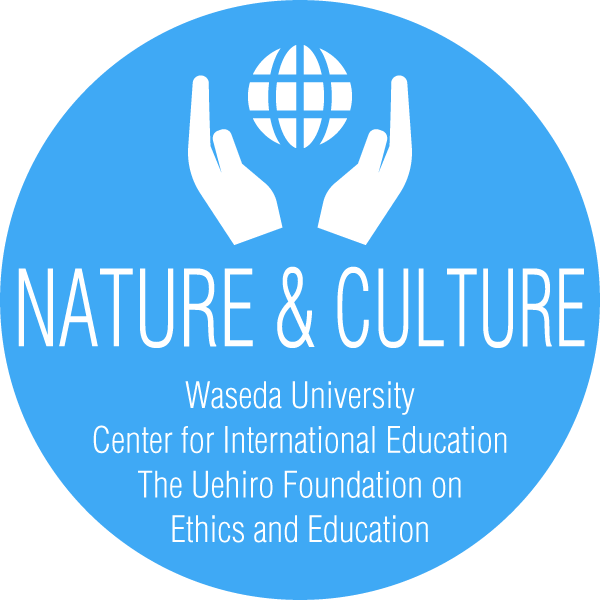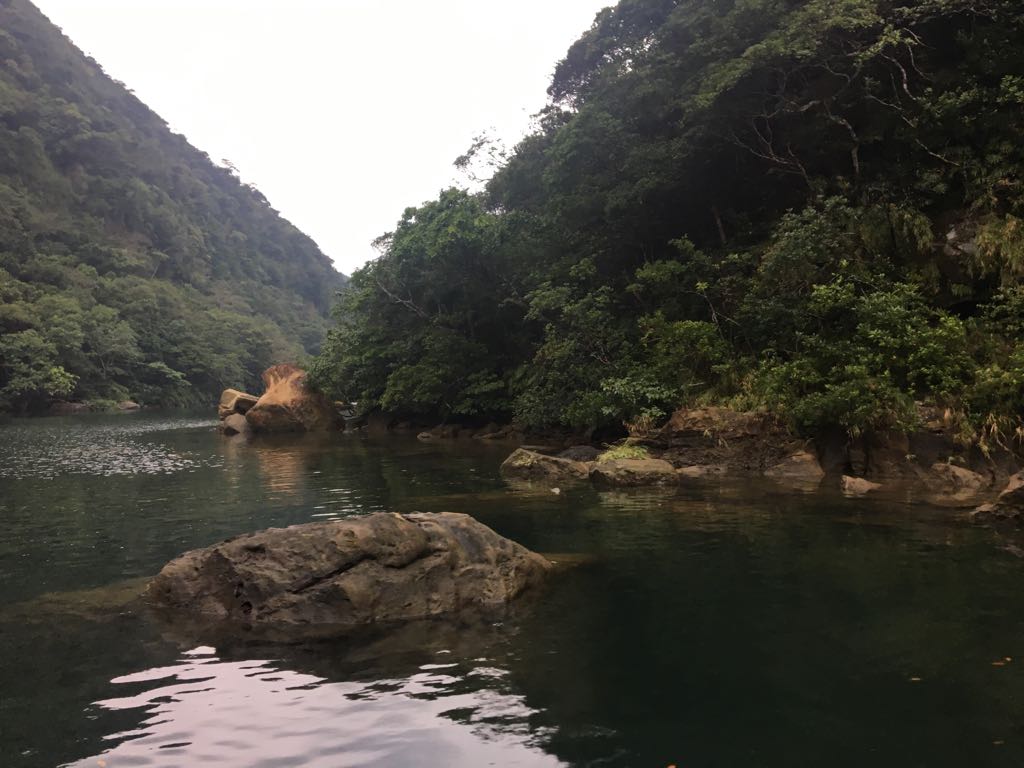Final Report by Anisa Shafiyya Harnantyari – Indonesia
Achieving Coexistence Between People and Nature
by Anisa Shafiyya Harnantyari – Indonesia
Environmental problems are complex to solve, and various efforts have been carried out in order to minimize and ultimately solve the problem. In “Think of the Environment though Culture”, we focused on the implementation of the Sustainable Development Goals (SDGs) and learned its relationship with the local people and their culture who are directly affected by it. In this course, we conducted two field works: Kamakura Field Work and Iriomote Island Field Work.
The Sustainable Development Goals (SDGs), also known as Agenda 20130, is a set of 17 global goals constructed by the United Nations in September 2015. These goals include targets in order to solve problems ranging from poverty, hunger, health, education, climate change, water, sanitation, energy, environment and social justice.[1] The SDGs, unlike previous goals, apply to all countries without any distinctions made between developed and developing countries.
The first field work that we conducted was in Yuigahama Beach in Kamakura. It was a short field work only lasting a day, but it was a very enjoyable learning experience. Our task was to pick up trash from the beach, as well as interview people that we found on the beach about their thoughts on the trash, who should be responsible for them, and how the problem could be solved. I was actually surprised as to how much trash we found on the beach. They include bottles, cans, food wrappers, and sometimes we found things that were unidentifiable. I wondered whether the trash really all came from the visitors on the beach, or maybe if they washed up ashore. We interviewed a group of local people, and they thought that visitors are responsible for the trash. They explained how tourists usually come in groups, have a picnic on the beach, and because there are no trash cans they leave their trash lying around. On the other hand, we also interviewed visitors who thought that the local people should be responsible for maintaining the beach and are therefore responsible for the trash that piles up. From these findings, I concluded that people do really like to blame others for problems instead of taking responsibility on their own. My thoughts are that everyone should be responsible for the trash. This whole planet is our home, and thus we should maintain it as we would do our own home. The local people, tourists, and everyone else must work together in order to preserve the beach. It is a shame because the view on Yuigahama Beach is breathtakingly beautiful, and yet we get distracted by how much trash there are on the beach. Various ideas on how to solve the problem include putting trash cans on the beach so that people would have a place to throw their trash. Most importantly, I think that education plays a vital role in solving the problem. By educating the harmful effects careless disposal of trash has on the environment, people can realize for themselves the consequences of their actions and would be willing to carefully dispose of their trash and continue to preserve the environment around them.

Beautiful sunset at Yuigahama Beach, Kamakura
The second field work that we conducted was in Iriomote Island in Okinawa Prefecture. Iriomote Island is the largest island in the archipelago of Yaeyama Islands in the most southern part of Japan. We stayed for four days and three nights, and it was a truly eye-opening experience. I was able to learn a lot of things through direct observations as well as by talking to the people in iriomote, things that I would never have gotten the chance to know and experiences I would never have gotten the chance to have anywhere else.
The first thing that I was able to observe during my time in Iriomote is the implementation of permaculture principles in real life. Permaculture is the philosophy of working with, rather than against nature; of thoughtful observation rather than thoughtless labor; and of looking at plants and animals in all their functions.[2] I learned that the local people of Iriomote truly value and appreciate the natural resource that surrounds them. During the interview with Ishigaki Akiko and Ishigaki Kinsei, we learned their philosophy of receiving from nature only what they need, and never to overconsume. They live on the principle that they live in coexistence with the nature around them, and in order to achieve balance they must always take care of it in the same way nature takes care of them. Ishigako Kinsei described how anyone could live in Iriomote for free. If you want to build a house, you can use woods from the trees. If you want to eat, there are a lot of animals that live on the island including fish and livestock. If you want to drink, there are many sources of water in the mountains. When asked whether he went to university, he replied by saying that he went to 山大学 (Mountain University). He said that the mountains have taught him a lot of valuable lessons that he cannot learn anywhere else. Every day during our trip, we also ate very healthy food that was taken directly from the plants and animals surrounding us in Iriomote. It was definitely an interesting experience because in Tokyo I eat a lot of unhealthy food either out in restaurants or from the コンビニ (convenience store). It was incredibly pleasant to eat such healthy food every day and I miss it even until now. At the hotel we stayed at, the chef said that he catches the fish and harvests the seaweed himself. He also mentioned that there’s a limit as to how much people can fish in order to prevent overfishing. This further shows how connected people are to the nature around them and how this connection is incorporated into each aspect of their daily lives, including their every meal.
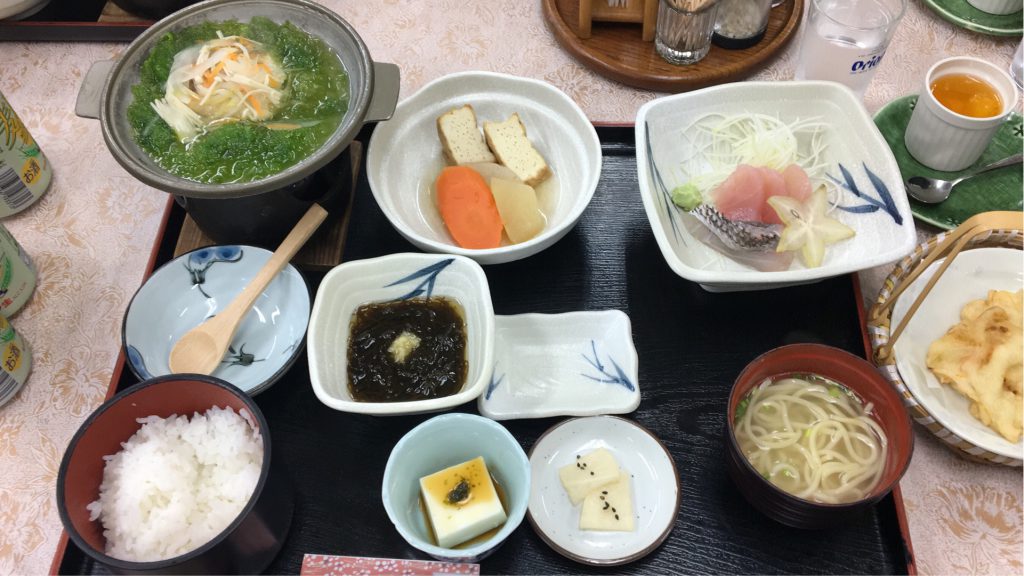
Healthy traditional Okinawan dinner
I also learned about the textile business that Ishigaki Akiko has established, of fabrics that only use natural materials and methods. The yarns are completely made from bananas, and the colors are from dyes from natural plants. I was personally really intrigued by the natural process that the fabric goes through. In Indonesia, I had a similar experience designing Batik, which is traditional Indonesian fabric patterns, using wax. It was interesting to see how different cultures have different and yet similar ways in cultivating the natural resources around them. Ishigaki Kinsei is responsible to search for the indigenous plant on the island where they can get the natural dye from, and he says that he only takes from the plant enough of what is needed, and then plants it back into the ground so that it can grow and in the future they can use it again. The whole process is very natural and honest, and this is translated into the quality of the textile that is produced.
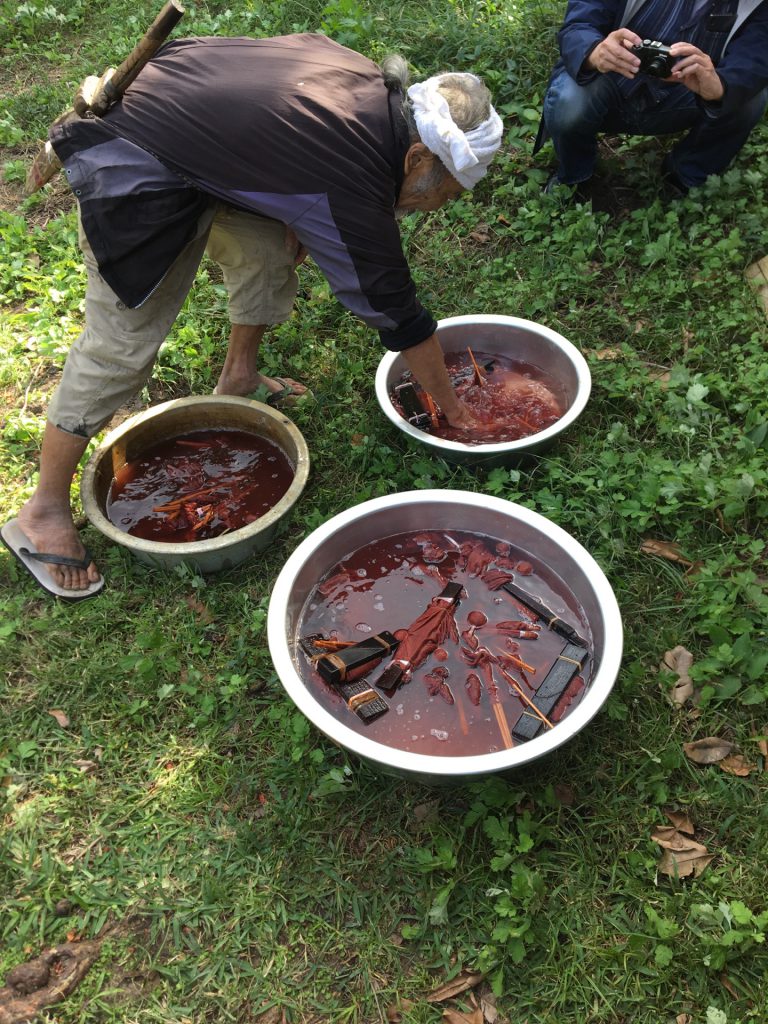
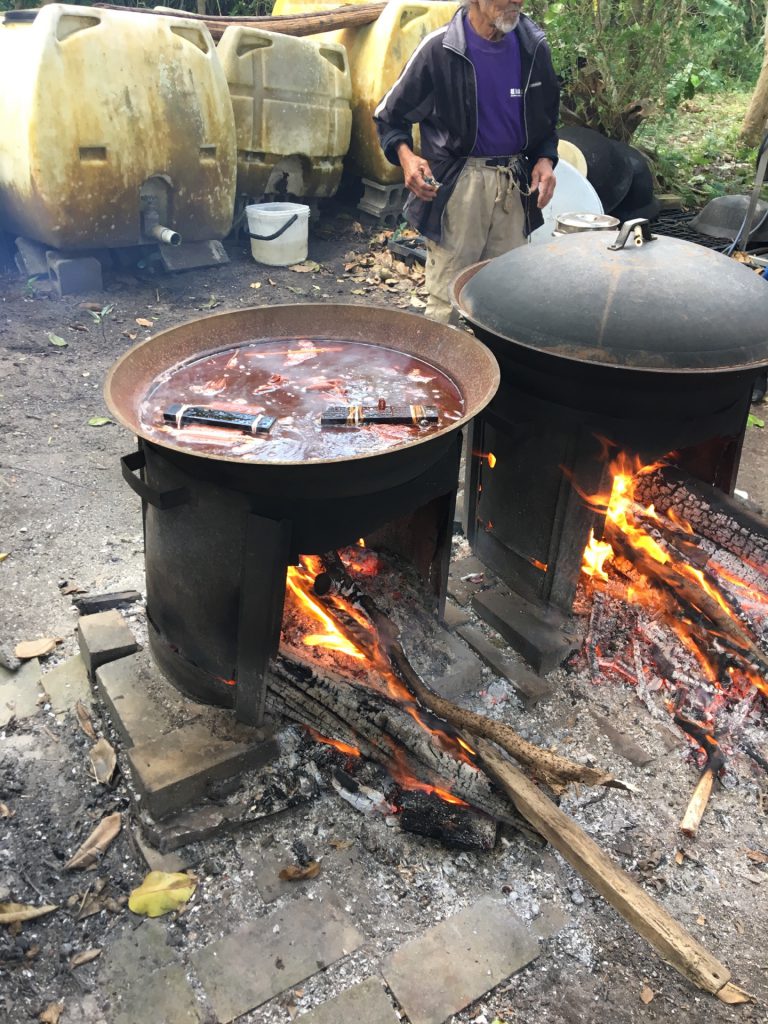
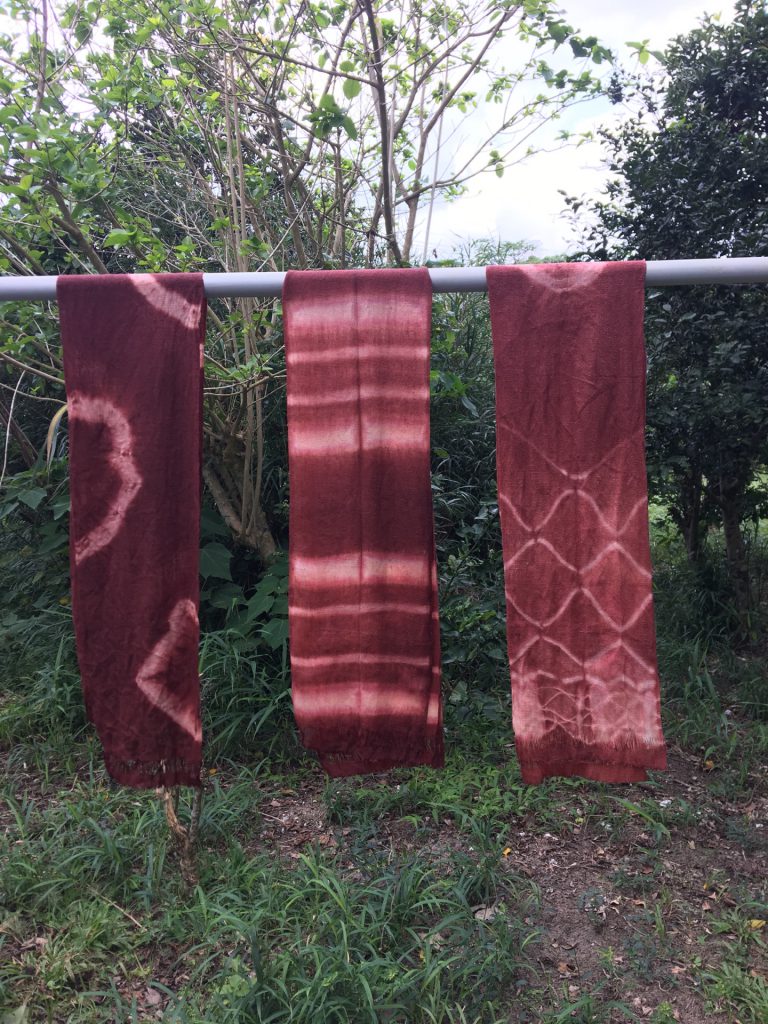
Process of making natural textile
Ishigaki Akiko have worked with big name designers such as Issey Miyake, and some of her works are displayed in various contemporary art museums. When asked how is she able to work with such popular designers, she simply answered that it is all because of Iriomote’s natural beauty. She said that by continuing to conserve and protect the nature in Iriomote, the beauty itself is able to attract people from all over the world. People will search and want to see for themselves something that is beautiful. This can also be seen by the fact that Ishigaki Akiko continues to receive students from all over the world that wants to learn how to create the textile that she makes. We were lucky to be given the opportunity to create our own textile patterns, and when doing so three of her students also helped us. In my opinion, this was one of the most fun activity that we did during our trip. I believe that the principles that the people of Iriomote live by connects directly with SDG #12: Responsible Consumption and Production, where there is an emphasis on only taking what they need from their surroundings and never overconsuming. Moreover, these principles are also applications of SDG #14: Life Below Water and #15: Life On Land. By consuming responsibly, they do not harm the wildlife that live around them and continue to preserve them. With the abundance of natural resources, they believe that they have more than enough thus feels satisfied.
Through the Iriomote Field Work, I also learned the importance of preserving cultural identity and heritage. As for Iriomote, this largely consists of its biodiversity. Iriomote is home to the famous Yamaneko, an endangered wildcat species indigenous only to the island. It is also home to the largest river in Okinawa Prefecture, the Urauchi River that is lined up with countless mangrove trees. Moreover, Iriomote has the largest waterfall in Okinawa Prefecture, the Pinaisara Falls. We had the opportunity to go on a boat ride and also canoe down the river, and during that time I was able to observe the mangrove plants as well as the surrounding biodiversity up close. The tour guide explained to us how the mangroves are self-sustainable. One interesting that I learned about mangroves is that they designate all the salt that the tree absorbs into only one leaf out of all the leaves that they have, and once it is fully concentrated the leaf will fall. This is the way the leaves protect themselves from the salt, thus is self-sustainable. Not only the mangroves, as we canoed down the river we also observed the other plants that lines up the river and even the water of the river itself. The river is very clear as we can see our reflections and the reflections of the surrounding plants clearly, and there are a lot of fish that lives in it. Another interesting thing that we found was ruins of an old mine on one side of the river. The things that we found shows how the river plays a huge role in the lives of the local people and it has done so from a long time ago. Recently, I think that the river has specifically brought in tourism to Iriomote and thus a livelihood for its people.
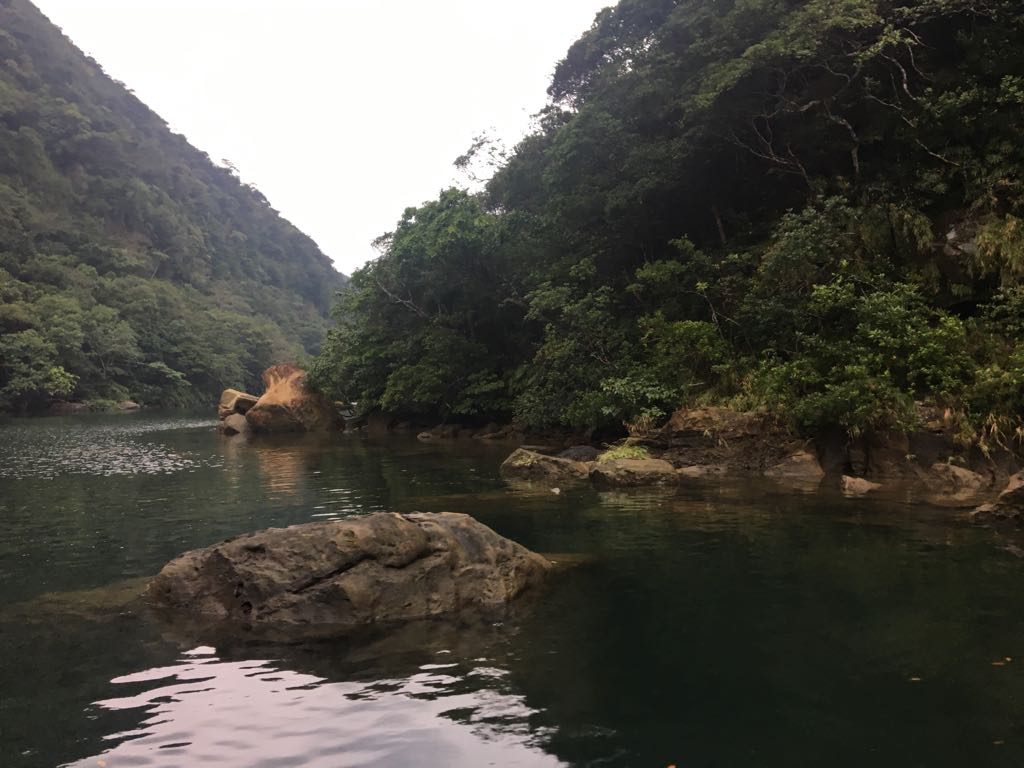
Cruising the Urauchi River
As for the Yamaneko, unfortunately we were not able to see a real one. However, we went to a shelter / cultural center where we learned more about the Yamaneko, as well as other animals that live on the island. During our visit at the center, I was able to learn more about the biodiversity on the island and fascinatingly, I was able to see a stuffed version of the Yamaneko. As I’ve mentioned above, I think that education plays a vital role in preserving the environment and I think the center really helps children from a young age understand its importance. I also noticed how the questions on the quiz that we did in the center uses easy Japanese so that young children can understand and participate. Due to the biodiversity of Iriomote, it has been put on a nomination list for a UNESCO World Heritage. As we spoke to Ishigaki Kinsei and Ishigaki Akiko about their thoughts on the matter, their response was not what I expected. They expressed their concerns of the matter, as they think that by achieving that title, things will definitely change in Iriomote. Specifically, they do not want the island to turn into an overcrowded tourist spot, with many resorts being built. They believe that this will harm the environment and the balance that now exists between the people and the nature in Iriomote. Moreover, they believe that this will cause Iriomote to lose their cultural identity. After hearing their concerns, I realized how important it is to consider the opinions of local people whenever environmental decisions are being made. Being a UNESCO World Heritage might sound appealing and beneficial on the outside, but if the effects are really being considered and weighed, it might actually bring more harm than good to the place. From this, I have learned how important it is to conduct efforts in order to preserve the cultural identity and heritage of a place, as in the end it ultimately preserves the environment.
In conclusion, I have understood the importance in having balance between human life and nature, as nature provides for us what we need and therefore we should only take as necessary. I have also realized the importance in maintaining cultural heritage and identity as it ultimately aims to achieve the preservation of the environment. This is the reason why before any environmental decisions are being made, or any goals are being set for a place, the effects on the local people as well as their culture must be considered. Their opinions and concerns should be heard as they are direct stakeholders, therefore having more knowledge of the place and will be directly affected by the decisions being made. If this can be done, we can achieve our goals in solving environmental issues through understanding culture.
References:
[1] “Sustainable development goals.” United Nations, United Nations, www.un.org/sustainabledevelopment/sustainable-development-goals/.
[2] Mollison, B. Introduction to permaculture. Tasmania, Australia: Tagari. 1991.
